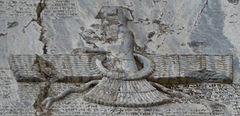| Islamic conquest of Persia | |||||||||
|---|---|---|---|---|---|---|---|---|---|
| Part of the Muslim conquests | |||||||||
 | |||||||||
| |||||||||
| Belligerents | |||||||||
|
Sassanid Persian Empire, Arab Christians | Rashidun Caliphate | ||||||||
| Commanders and leaders | |||||||||
|
Emperor Yazdegerd III † |
Caliph Abu Bakr | ||||||||
 |
| History of Greater Iran |
|---|
The Islamic conquest of Persia led to the end of the Sassanid Persian Empire in 644, Sassanid dynasty in 651 and the eventual extirpation of the Zoroastrian religion in Persia. Sassanid Persian empire was first invaded by Muslims in Iraq in 633 under legendary general Khalid ibn Walid, which resulted in Muslim conquest of Iraq. Following the transfer of Khalid to Roman front in Levant, Muslims eventually lost Iraq to Persian counter attacks. The second invasion of Iraq begun in 635 under Saad ibn Abi Waqqas when after a key victory at Battle of Qadisiyyah Sassanid controll west of Persia was perminently ended. Zagros mountains became a natural barrier and borders between Rashidun Caliphate and Sassanid empire. Owing to continous raids of Persians in Iraq, Caliph umar ordered a whole scale invasion of Sassanid Persian empire in 642 which came to an end with complete conquest of Sassanid empire by mid 644. The quick conquest of Persia in series of well coordinated multi-pronged attacks, operated by Caliph Umar from Madinah several thousand miles from the battle fields in Persia, became his greatest triumph, marking his reputation among the greatest strategists and political genius of history. Most Muslim historians have long offered the idea that Persia, on the verge of the Arab invasion, was a society in decline and decay and thus it embraced the invading Arab armies with open arms. This view is not widely accepted however. Some authors have for example used mostly Arab sources to illustrate that "contrary to the claims of Muslim apologists, Iranians in fact fought long and hard against the invading Arabs."[1] This view further more holds that once politically conquered, the Persians began engaging in a culture war of resistance and succeeded in forcing their own ways on the Arabs.[2][3]
- ^ Milani A. Lost Wisdom. 2004 ISBN 0934211906 p.15
- ^ Mohammad Mohammadi Malayeri, Tarikh-i Farhang-i Iran (Iran's Cultural History). 4 volumes. Tehran. 1982.
- ^ ʻAbd al-Ḥusayn Zarrīnʹkūb (1379 (2000)). Dū qarn-i sukūt : sarguz̲asht-i ḥavādis̲ va awz̤āʻ-i tārīkhī dar dū qarn-i avval-i Islām (Two Centuries of Silence). Tihrān: Sukhan. OCLC 46632917, ISBN 964-5983-33-6.
{{cite book}}: Check date values in:|year=(help)CS1 maint: year (link)